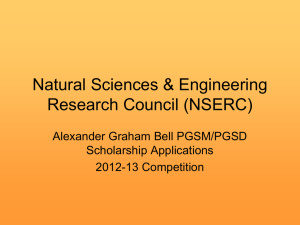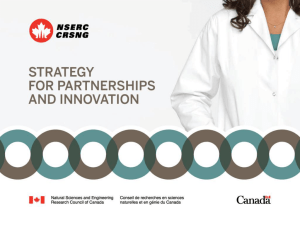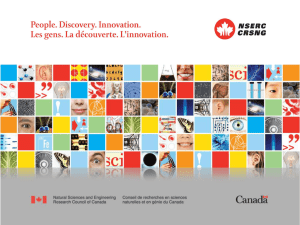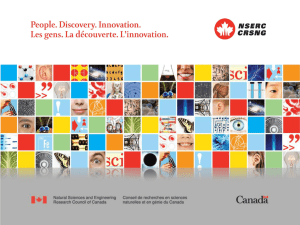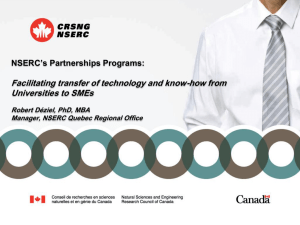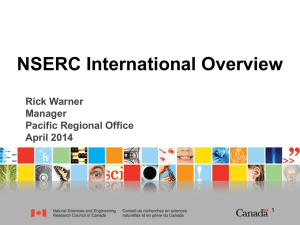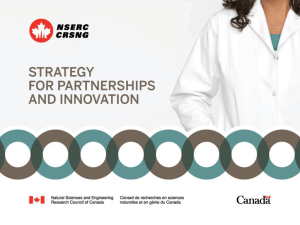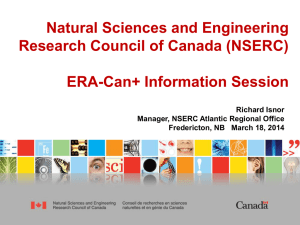nserc-info-session-may-2014
advertisement
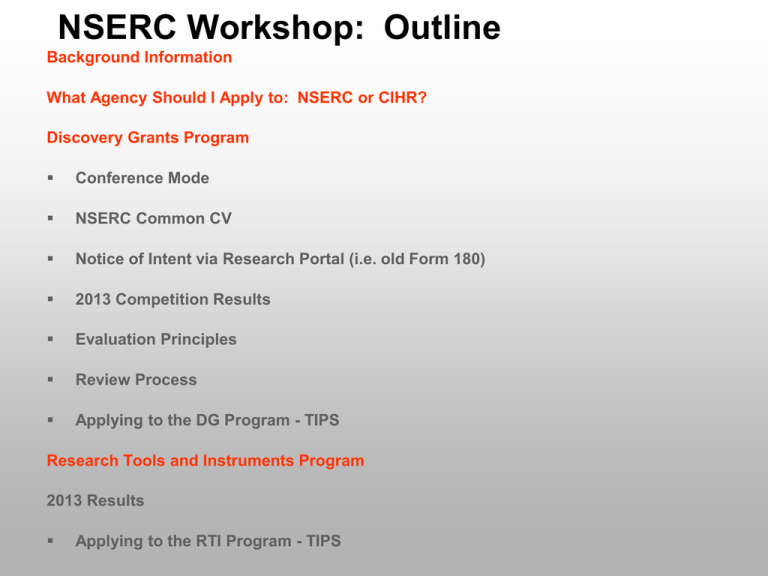
NSERC Workshop: Outline Background Information What Agency Should I Apply to: NSERC or CIHR? Discovery Grants Program Conference Mode NSERC Common CV Notice of Intent via Research Portal (i.e. old Form 180) 2013 Competition Results Evaluation Principles Review Process Applying to the DG Program - TIPS Research Tools and Instruments Program 2013 Results Applying to the RTI Program - TIPS Brian Keay: My Background Current (since 2008) Vice Dean Assoc. Dean Research Assoc. Dean Academic Affairs •Professor, Department of Chemistry (organic synthetic chemist) Past Head of Chemistry, July 2002 – December 2008 NSERC GSC 024 member (2001-2003) Chair of NSERC Chemistry RTI Committee (2003) 2010 NSERC DG Competition Result: Merit of Researcher: VS Proposal: S HQP: VS Binned at $50K Please Sign the Signature Page Being Circulated An electronic version of the following will be sent to you: 1. This PowerPoint Presentation 2. Tips from Recent Evaluation Group Members 3. Analysis of Form 101 from my 2010 DG application (Chemistry Evaluation Group 1504) 4. RSO Checklist Where is the Information within this Workshop Coming From? Used information from the following: Talked with PIs who served on Evaluation Groups (EG) (2009-14) NSERC “How to Apply for a DG” Presentation (2011) Faculty of Science DG Results (2009 – 2014) NSERC Website (2011 - 2014) NSERC Presentation to Heads of all chemistry departments across Canada (2011 - 2013) EG Comments to PIs in FofS (2010 - 2014) Past NSERC Workshop Attendee Statistics Science Success Rates Applying for NSERC DG Science 2009 2010 2011 2012 2013 Attended 75% (27 of 36) 60% (21 of 35) 79% (26 of 33) 88% (36 of 41) 84% (26 of 31) Not Attended 56% (14 of 25) 44% (4 of 9) 56% (9 of 16) 60% (6 of 10) 57% (8 of 14) Useful NSERC Documents: 2013 Competition Statistics-DG Program http://www.nserc-crsng.gc.ca/_doc/Professors-Professeurs/2013DGStats_e.pdf Discovery Grant Information Centre http://www.nserc-crsng.gc.ca/Professors-Professeurs/DGIC-CISD_eng.asp Peer Review Manual – 2013-14 http://www.nserc-crsng.gc.ca/NSERC-CRSNG/Reviewers-Examinateurs/IntroPRManualIntroManuelEP_eng.asp List of Evaluation Groups and Research Topics http://www.nserc-crsng.gc.ca/Professors-Professeurs/Grants-Subs/DGPList-PSDListe_eng.asp Merit Indicators http://www.nserc-crsng.gc.ca/_doc/Professors-Professeurs/DG_Merit_Indicators_eng.pdf Which Agency Should I Apply To: NSERC or CIHR? On Oct. 4, 2013, NSERC sent the following email to an applicant: NSERC's mandate is to support research in the Natural Sciences and Engineering (NSE), other than the Health Sciences. Based on the preliminary information provided in your NOI, it is not clear whether the subject matter of the proposed research is within NSERC's mandate. We realize that the information in the NOI is limited, hence our decisions on mandate eligibility will be based on the full DG application. We encourage you, in the preparation of your application, to consult the Tri-Agency Guidelines in order to determine whether your work contributes predominantly to the NSE or not. Also note that if your application is deemed to be outside of NSERC's mandate, it will be rejected and our decision may come as late as February 2014. Which Agency Should I Apply To: NSERC or CIHR? (taken from: http://www.science.gc.ca/default.asp?lang=En&n=FEE7261A-1#NSERC1) General Guidelines for the Eligibility of Subject Matter at NSERC Applications to NSERC as the primary source of research or research training support must meet the following criteria: The program of research must be primarily in the natural sciences and engineering; The intended objectives of the research must be, primarily, to advance knowledge in one of the natural sciences or in engineering. General Guidelines for Eligibility of Subject Matter at CIHR Applications to CIHR as the primary source of research or research training support must meet the following criterion: The intended outcomes of the research must, as stated in CIHR’s mandate, primarily improve or have an impact on health and/or produce more effective health services and products and/or strengthen the Canadian health care system. Guidelines for the Eligibility of Applications Related to Health (http://www.science.gc.ca/default.asp?lang=En&n=FEE7261A-1#NSERC1) NSERC: The primary objective of any research supported by NSERC must be to advance knowledge and training in the natural sciences or engineering (NSE). The question to be asked is: does the research challenge lie within the NSE? Proposals that include the use of methodologies, tools, techniques and knowledge from the NSE are not automatically considered eligible by NSERC. The following are considerations when preparing or assessing the eligibility of the subject matter of applications related to health: Eligible for NSERC support: •Research in animal health and veterinary medicine. •Research in nutrition related to food components, nutraceuticals (as defined in Health Canada’s Policy Paper – Nutraceuticals/Functional Foods and Health Claims On Foods), or functional foods. Guidelines for the Eligibility of Applications Related to Health (http://www.science.gc.ca/default.asp?lang=En&n=FEE7261A-1#NSERC1) Eligible for NSERC support (continued) •Research seeking to further our understanding of fundamental processes in humans. •Research whose primary purpose is the development of monitoring and diagnostic technologies (such as health IT, in-vitro diagnostics, diagnostic imaging, patient monitoring, and endoscopic devices) unless it is at the clinical trials stage (as defined by the International Conference on Harmonisation (ICH) Guidelines to Good Clinical Practice). The research challenge must lie within the NSE. •Research whose major challenges lie in the NSE (materials science, engineering, computer science, chemistry, etc) which could eventually lead, among other applications, to the treatment or prevention of human disease. Guidelines for the Eligibility of Applications Related to Health (http://www.science.gc.ca/default.asp?lang=En&n=FEE7261A-1#NSERC1) Not eligible for NSERC support: •Research involving the refinement of already existing technology for facilitating clinical therapies or health delivery systems. •Research whose primary purpose is the investigation or development of vaccines, active pharmaceutical ingredients (API), or other therapeutic agents for human applications. •Research whose primary purpose is the investigation/treatment of injuries or human performance. •Research seeking to develop animal models of human diseases in order to study primarily the disease state, or treatments for injuries or diseases represented by the model. •Applied research for disease treatment, diagnosis or prevention. •Research involving clinical trials (as defined by the International Conference on Harmonisation (ICH) Guidelines to Good Clinical Practice). http://www.hc-sc.gc.ca/dhp-mps/prodpharma/applic-demande/guideld/ich/efficac/e6-eng.php CIHR (http://www.science.gc.ca/default.asp?lang=En&n=FEE7261A-1#NSERC1) CIHR considers applications across the full spectrum of health research. CIHR categorizes health research in four broad themes: 1. bio-medical research; 2. clinical research; 3. research respecting health systems and services; and 4. research into the health of populations, societal and cultural dimensions of health, and environmental influences on health. Four broad definitions of the CIHR themes are included on the next slide for reference purposes. These areas of research are not mutually exclusive; therefore the definitions are intended as guides and not as descriptions of eligible areas of research. CIHR (http://www.science.gc.ca/default.asp?lang=En&n=FEE7261A-1#NSERC1) Bio-medical Research Research with the goal of understanding normal and abnormal human functioning, at the molecular, cellular, organ system and whole body levels, including development of tools and techniques to be applied for this purpose; developing new therapies or devices that improve health or the quality of life of individuals, up to the point where they are tested on human subjects; studies on human subjects that do not have a diagnostic or therapeutic orientation. Clinical Research Research with the goal of improving the diagnosis and treatment (including rehabilitation and palliation) of disease and injury; improving the health and quality of life of individuals as they pass through normal life stages; research on, or for the treatment of, patients. Health Services Research Research with the goal of improving the efficiency and effectiveness of health professionals and the health care system, through changes to practice and policy. Health services research is a multidisciplinary field of scientific investigation that studies how social factors, financing systems, organizational structures and processes, health technologies, and personal behaviours affect access to health care, the quality and cost of health care, and, ultimately, Canadians' health and well-being. Social, Cultural, Environmental and Population Health Research with the goal of improving the health of the Canadian population, or of defined subpopulations, through a better understanding of the ways in which social, cultural, environmental, occupational and economic factors determine health status. Discovery Grants Information Centre http://www.nserc-crsng.gc.ca/Professors-Professeurs/DGIC-CISD_eng.asp This web site is new and contains links to: Basic information Use of Discovery Grant Funds for Research Instruments and Equipment Discovery Grants Program description Discovery Accelerator Supplements Program description Peer Review Manual: Section 6 for Discovery Grants, Section 7 for RTI List of Evaluation Groups and Research Topics Programs Selection Committees Merit indicators On-line Services (includes the on-line application system) Appeal Process Competition results and statistics (2013 DG Competition Stats are available) Consultations and changes to review process Questions and answers FAQ: Discovery Grants Competition Application information, intellectual property and funding decisions Grant Selection Committee Structure Review Eligibility http://www.nserc-crsng.gc.ca/NSERC-CRSNG/Eligibility-Admissibilite/faculty-corpsprof_eng.asp University faculty: To be eligible as an applicant or co-applicant, you must hold or have a firm offer (1) of an academic appointment at an eligible Canadian university at the time of application. (2) The appointment can be: a) a tenured, tenure-track or lifetime professor emeritus position; or b) a term or contract position of no less than three years.3 1. Appointments that are conditional on obtaining NSERC grants or other sources of support will be considered ineligible. 2. In exceptional circumstances, offers that are still pending approval at the time of application can be finalized and confirmed in writing to NSERC within six weeks following the application deadline. 3. Appointments for which the source of funding is not guaranteed for at least three years (e.g., renewable yearly subject to the availability of funds) will be considered ineligible. Categories of Researchers From Peer Review Manual 2013-14, Section 6.5 Early Career Researchers (ECR) are applicants who are within two years of the start date of their first eligible position at the university (from July of the year of the application deadline) and who have no prior academic or nonacademic independent research experience. All other applicants are Established Researchers (ER) Early Career Researchers All applications are evaluated against the same expectations for the 3 selection criteria; -after evaluation of all applications, the Executive Committees will aim to support at least 50% of ECR applicants; subject to the assurance of high quality; -NSERC considers it important to allow ECRs to demonstrate their potential for quality contributions to research and training; -ECRs should not be rated as Insufficient due solely to the fact of not having a training record; the review should focus on the plan for future training; -ECRs who continue to collaborate with previous supervisors, or who carry out research as part of a group, should clearly define their contributions to the collaborate work. Adjunct and Emeritus Professors -NSERC policy is to recognize and support the important role played by adjunct and emeritus professors in university-based research; -applications are evaluated using the same criteria, scale, indicators and timeframe (past 6 years) as all other applicants; -if appointment does not permit sole supervision of HQP, it is expected that a satisfactory plan for co-supervision will be presented and clearly described in the application. The onus is on the applicant to provide sufficient information to enable EGs to assess this appropriately; -adjunct professors in industry: NSERC will normally award funds only for the direct support of students i.e. salaries or stipends and student travel costs) Overall National Comparative Statistics Overall Comparative Statistics 2008-2012 No. of Applicants (include 1st time) Average grant Average grant (includes subatomic physics) Overall Early Career Researchers (ECR) Established Researchers (ER) applicants who held a grant applicants previously unsuccessful $ $ 2008 3405 721 29,818 31,142 71% 2010 3355 532 $ 33,120 $ 35,143 2011 3482 457 $32,186 n/a Success Rates 64% 59% 58% 58% 57% 54% 62% 62% 63% 60% n/a 66% 79% 33% 72% 29% 74% 33% 78% 36% 76% 30% 80% 37% $ $ 2009 3210 637 33,713 38,416 2012 2013 3420 3398 480 471 $ 31,244 $ 33,472 n/a n/a 2014 3190 n/a n/a n/a NSERC continued to put a strong emphasis on giving early career researchers (ECR) a chance to Demonstrate their potential and exceeded the minimum target success rate of 50% NSERC is devoting funds to enhance the DGs of ECRs in the form of supplements to their grants: $5000 per year. UofC NSERC DG Results 11-14 University of Calgary NSERC DISCOVERY GRANT COMPETITION 2011 # of applications # of awards Success rate Total awarded 119 60 ~50% $9,103,000.00 (5 year total) 2013 # of applications # of awards Success rate Total awarded 2012 # of applications 117 # of awards 77 Success rate 66% Total awarded $10,887,200.00 2014 145* 89 61% $15,312,320 *Does not include one application that was withdrawn at applicant’s request 21 UofC NSERC DG Results 11-14 22 Science NSERC DG Results 2014 2014 Overall Science DG Results 2014 Overall Science DG Results by Department 23 2013 Statistics by Evaluation Group (EG) Comparing 2009 and 2008 Competitions Change in Grant Amount 2 0 0 ,0 0 0 1 8 0 ,0 0 0 N ew A m ount (in $) 1 6 0 ,0 0 0 1 4 0 ,0 0 0 1 2 0 ,0 0 0 1 0 0 ,0 0 0 8 0 ,0 0 0 6 0 ,0 0 0 4 0 ,0 0 0 2 0 ,0 0 0 0 2008 0 2 0 ,0 0 0 4 0 ,0 0 0 6 0 ,0 0 0 8 0 ,0 0 0 1 0 0 ,0 0 0 1 2 0 ,0 0 0 1 4 0 ,0 0 0 1 6 0 ,0 0 0 1 8 0 ,0 0 0 2 0 0 ,0 0 0 1 4 0 ,0 0 0 1 6 0 ,0 0 0 1 8 0 ,0 0 0 2 0 0 ,0 0 0 P r e v io u s A m o u n t (in $ ) 2 0 0 ,0 0 0 1 8 0 ,0 0 0 N ew A m ount (in $) 1 6 0 ,0 0 0 1 4 0 ,0 0 0 1 2 0 ,0 0 0 1 0 0 ,0 0 0 8 0 ,0 0 0 6 0 ,0 0 0 4 0 ,0 0 0 2 0 ,0 0 0 0 0 2009 2 0 ,0 0 0 4 0 ,0 0 0 6 0 ,0 0 0 8 0 ,0 0 0 1 0 0 ,0 0 0 1 2 0 ,0 0 0 P r e v io u s A m o u n t (in $ ) The Conference Model and Process for Binning Applications General Statements from Peer Review Manual (2013-14) The onus is on the applicant to submit a complete application and one that conforms to the presentation standards and instructions established by NSERC. Incomplete applications that do not meet the requirements may be rejected or pages may be removed by NSERC. Pages in excess of the number permitted are removed. DG applications are assessed on the basis of the following 3 selection criteria: 1. Scientific or engineering excellence of the researcher; 2. Merit of the proposal; and 3. Contributions to the training of highly qualified personnel (HQP) The Conference Model and Process for Binning Applications General Statements from Peer Review Manual (2013-14) The assessment of each criterion is based on the achievements demonstrated over the past 6 years. Each criterion is important and has equal weight when determining the overall quality category (bin) for the application. The process for determining funding recommendations is separate. All applicants, ECR and ER, are evaluated using the same merit indicators. Evaluation Process Overview Two-step process separates merit assessment from funding recommendations 1. a) Merit assessment uses six-point scale to evaluate: – Excellence of the Researcher – Merit of the Proposal – Contributions to the Training of Highly Qualified Personnel (HQP) b) Applications grouped in “bins” of comparable merit 2. Funding recommendations done at the end of competition week ─ similar overall ratings within an Evaluation Group receive comparable funding, with possible modulation related to Cost of Research Relative Cost of Research Determined by the reviewers as Low, Normal or High as compared to the norm for the research areas represented in the applications considered by the Evaluation Group(s). Factors considered include: – – – – – Salaries and benefits Equipment and/or facilities Materials and supplies Travel Dissemination Discovery Grant Indicators Section A1-1 Research Topic A1 Section C3-2 Research Topics C5 and A5 Section C3-1 Research Topic C4 Section C2 Research Topic C3 Section C1-1 Research Topics C1 and B5 Section B4-1 Research Topics B2 and B6 Section B4-2 Research Topics B7 and C6 EVALUATION GROUP B Group Chair ~35 members 4 Section Chairs Section C1-2 Research Topic C2 Section B3-1 Research Topic B4 Section B3-2 Research Topics B1 and B5 Section B2 Research Topic B3 Section B1-1 Research Topic B1 Section A4-1 Research Topics A7 and A8 Section A4-2 Research Topics A9 and B5 EVALUATION GROUP A Group Chair ~ 40 members 4 Section Chairs Section B1-2 Research Topics B2 and A10 Section A3-1 Research Topic A5 Section A3-2 Research Topic A6 Section A2 Research Topic A3 Section A1-2 Research Topics A2 and A4 How Does the Conference Model Work? EVALUATION GROUP C Group Chair ~25 members 3 Section Chairs NSERC Discovery Grants Three systematic and transparent assessment criteria 1. Scientific excellence of the researcher 2. Merit of the proposal 3. Contribution to the training of HQP Each criteria will be assessed on a scale of 6 (see NSERC website): Exceptional 6 Outstanding 5 Very strong 4 Strong 3 Moderate 2 Insufficient 1 (all GSC’s use the same system) NSERC Discovery Grants In “Excellence of Researcher” at least a rating of strong is required to receive funding: NSERC is committed to “excellence” and does not want to fund “moderate” researchers NSERC Discovery Grants Researcher Proposal 6 (E) 6 HQP 6 5 (O) 5 5 4 (VS) 4 4 3 (S) 3 3 2 (M) 2 2 1 (I) 1 1 Funding BIN 18 A 17 B 16 C 15 D 14 E 13 F 12 G 11 H 10 I 9J 8K 7L 6M 5N 4O 3P 2013 NSERC Discovery Grants: Chemistry Funding BIN 18A 17B 16C 15D 14E 13F 12G 11H 10I (VS,S,S) 9J (S,S,S) 8K (S,S,M) 7L 6M 5N 4O 3P Funding* Level [$/year] 124,000-155,000 100,000 82,000 cutoff for 65,000 established 55,000 researchers 42,000 35,000 30,000 (ECR only) 28,000 (ECR only) cutoff for 0 early career 0 researchers 0 0 0 * Recommended by EG together with group chairs and NSERC staff 2013 NSERC Discovery Grants: Chemistry August 1 Submit NOI and NSERC CCV via Research Portal Notice of Intent to Apply for a Discovery Grant http://www.nserc-crsng.gc.ca/Professors-Professeurs/Grants-Subs/DGIGP180NoticePSIGP180Avis_eng.asp ** Change in Application Procedures – Notice of Intent mandatory ** The Notification of Intent to Apply for a Discovery Grant (old Form 180) is now mandatory when applying for a Discovery Grant and must be submitted by August 1 along with your NSERC CCV via the Research Portal website (https://portal-portail.nserc-crsng.gc.ca/s/login.aspx). Applicants who do not submit a Notice of Intent and CCV will not be eligible to Submit an Application for a Grant (Form 101) in the fall. In addition, NSERC is reinforcing its policy on deadlines. NOIs and CCVs will not be accepted after their respective deadline dates. NSERC NOI Instructions http://www.nserc-crsng.gc.ca/ResearchPortal-PortailDeRecherche/InstructionsInstructions/index_eng.asp NOI and CCV are At the Research Portal 1. Create an Account 2. Fill out your User Profile 3. Create an Application (i.e. NOI) DG Individual Application overview page (edit application and upload NSERC CCV here) 1. Identification (input main Evaluation Group) 2. Activity Details (input research topics and keywords) 3. Summary of Proposal (limited to 5000 characters) 4. External Reviewer Suggestions (up to 5) 5. Reviewer Exclusion Once you have verified each page and uploaded your NSERC CCV, a ‘submit’ button will appear. Key Words and Summary of Proposal •Choose your key words carefully. •Summary of Proposal The summary of proposal must not exceed 5000 characters. It should: 1. state the objectives of the proposed research program; 2. summarize the scientific approach; and 3. highlight the novelty and expected significance of the work to a field(s) in the natural sciences and engineering. . •Both will be used to assist NSERC in determining the type of expertise that will be needed to evaluate your application (more later on how the conference model works). Notification of Intent (http://www.nserc-crsng.gc.ca/ResearchPortal-PortailDeRecherche/Instructions-Instructions/NOI-DG_NOI-DG_eng.asp) •Choose your Evaluation Group and Sub-Research Topics carefully. 1501 Genes, Cells and Molecules 1502 Biological Systems and Functions 1503 Evolution and Ecology 1504 Chemistry 1505 Physics – includes Subatomic Physics Discovery Individual and Group, but not Projects 1506 Geosciences 1507 Computer Science 1508 Mathematics and Statistics 1509 Civil, Industrial and Systems Engineering 1510 Electrical and Computer Engineering 1511 Material and Chemical Engineering 1512 Mechanical Engineering http://www.nserc-crsng.gc.ca/Professors-Professeurs/Grants-Subs/DGPList-PSDListe_eng.asp#1506 e.g. 1504 Chemistry - Sub-Research Topics CH01 Inorganic Synthesis CH02 Inorganic Catalysis CH03 Physical Properties and mechanisms of Inorganic Compounds CH04 Organic Synthesis CH05 Organic Catalysis CH06 Chemistry of biological systems CH07 Characterization of biological systems CH08 Physical Properties and mechanisms of Organic Compounds CH09 Photochemical reactivity and dynamics CH10 Photonics CH11 Theoretical physical chemistry CH12 Nuclear chemistry CH13 Development and applications of spectroscopic and structural techniques CH14 Atmospheric and Environmental Chemistry CH15 Analytical chemistry CH16 Combustion and Fuel Chemistry CH17 Functional Materials CH18 Polymer and Colloid chemistry CH19 Surface and Interfacial Chemistry CH20 Electrochemistry CH21 Nanomaterials CH22Supramolecular chemistry http://www.nserc-crsng.gc.ca/Professors-Professeurs/Grants-Subs/DGPList-PSDListe_eng.asp#1506 Notice of Intent – choosing referees http://www.nserc-crsng.gc.ca/ResearchPortal-PortailDeRecherche/Instructions-Instructions/NOI-DG_NOI-DG_eng.asp Choose your potential external referees carefully (according to NSERC you are not suppose to contact them) From Dr. Masad Damha (2008 Chair GSC 024) “….write a winning proposal, and select your reviewers carefully. Most of them will be selected, particularly if you do a good job identifying people who can read them, and have a good stature. I find foreign reviewers do a poor job; either they are too brief (superficial), or they over do it. “ •You can indicate who you do not want to review your DG! You may request that some researchers not be involved in the review of your application. This request should specify the above-mentioned information for referees and should be submitted with your NOI . Canadian Common CV (CVV) (http://www.nserc-crsng.gc.ca/OnlineServices-ServicesEnLigne/instructions/180/e.asp) •CCV – How to Complete NSERC’s Version (http://www.nserc-crsng.gc.ca/ResearchPortal-PortailDeRecherche/Instructions-Instructions/index_eng.asp) •NSERC CCV FAQ (http://www.nserc-crsng.gc.ca/ResearchPortal-PortailDeRecherche/FAQ-FAQ/CCV-CVC_eng.asp) START NOW!! Research Services CCV Workshops 1) May 30, 2014, 1-4 pm, TFDL 440B (Learning Room) 2) July 10, 2014, 1- 4 pm, TFDL 440B (Learning Room) Your CCV can be updated up to the submission date of October 31, 2014. CCV: Tips List all sources of support List all other research contributions Explain your role in collaborative research activities Describe contributions to HQP training – Describe nature of HQP studies (esp. Master’s and undergraduates) CCV: Tips Include as much information as possible List your student’s names in bold font in the list of contributions Explain your role in co-supervision activities Give other evidence of impact of work Explain any delays in research activity or particular circumstances that might have affected productivity or contributions to HQP training Evaluation Criteria, TIPS and Things to be Aware of when preparing a DG............. As can be seen by the NSERC data, there are more applications and need for research funds than what NSERC can supply. Thus in some cases (especially in categories J and K) Evaluation Committee members could be looking for reasons not to fund a particular proposal. Thus you need to pay attention to all the NSERC guidelines when filling out an application. Some of you are going to consider some of my suggestions petty, tedious, and/or pedantic, but as you will see later, not paying attention to all this detail could result in a negative result, i.e. binned at a low level or no award. 1) Scientific or Engineering Excellence of the Researcher(s) Knowledge, expertise and experience; -stature in field (awards and prizes received) -invitations to lectures, write review articles and chair conference sessions -membership on committees, editorial/advisory boards -involvement in public outreach activities Quality of contributions to, and impact on, the proposed and other areas or research in the NSE; -research accomplishments by quality of recent contributions and overall level of contribution (impact) to research -assessment based on quality and impact of all contributions, not only on the number of publications or conference presentations -impact does not refer to impact factors of journals or H-index, but on influence that results have had on other researchers -describe your intellectual contribution to collaborative work or joint publications 1) Scientific or Engineering Excellence of the Researcher(s) Quality of contributions to, and impact on, the proposed and other areas or research in the NSE (con’t) -impact can be in advancing knowledge, developing technology, or addressing socio-economic or environmental needs -applicants can discuss contributions made more than 6 years ago, but for which the impact is being felt now (in Most Significant Contributions section) Importance of contributions to, and use by, other researchers and end-users; -extent to which applicant’s work has advanced the field; i.e. created significant changes in thought within the research area -patents, technical reports, development of standards or codes must be considered Complementarity of expertise and synergy of the members of the team (for team grants); 2) Merit of the Proposal Program versus Project The Discovery Grants Program supports ongoing programs of research (with long-term goals) rather than a single short-term project or collection of projects. If projects are defined without being placed in the broader context of a program, the indicators show that a rating of Insufficient is warranted. 2) Merit of the Proposal Originality and innovation; -to what extent does the proposal suggest and explore novel or potentially transformative concepts and lines of inquiry Significance and expected contributions to research; potential for technological impact; -what will be the likely impact of the research? -will it advance knowledge in the field? Clarity and scope of objectives; -are there long-term goals as well as short-term objectives? -is relationship between STO and LTG clear? -are objectives specific, well-focused and realistic? 2) Merit of the Proposal Clarity and appropriateness of methodology; -does the proposal clearly outline the methodology to be used? -is the proposed methodology current and appropriate, i.e. will it contribute to the stated research goals; has the applicant justified the methodological approach? Feasibility; -will applicant’s expertise and proposed methodology allow the objectives to be researched within the proposed time frame? -does the applicant have access to the necessary equipment and resources? -has the applicant anticipated potential problems and proposed mitigating measures? 2) Merit of the Proposal Extent to which the proposal addresses all relevant issues; -does application sufficiently outline recent progress related to the proposal? -has the applicant framed the research with appropriate references? Appropriateness of and justification of the budget; -does the budget request relate well to proposed methodology and expected outcomes? Relationship to other sources of funding; -is there a clear explanation of the conceptual and budgetary relationship between the proposed work and other funds held by the applicant? -Is there any budgetary overlap? Grant Proposal: Tips Write summary in plain language (this could be more important that you might think!) Provide a progress report on related research Position the research within the field and state-of-the-art Clearly articulate short- and long-term objectives Provide a detailed methodology Grant Proposal: Tips Clearly define your role in any collaborative research and planned joint HQP training Describe plans for quality HQP training (separate page in 2014) Present realistic budget Discuss relationships to other research support IMPORTANT Consider comments/recommendations from the EG that you received from your last unsuccessful attempt. 3) Training of HQP The training of HQP is an essential criterion for DG program. It is not sufficient for an applicant to have a solid track record and propose a worthy research program; For a meritorious ranking, the application must convince reviewers of the impact and quality of research training activities; Includes both the record (past) and the plans for future training. Quality and impact of contributions to training during the last six years: -not assessed solely in terms of the number and level supervised but assessed in terms of its quality and impact; -provide role as co-supervisors; -assess the suitability of the research proposed and HQP plans -it is usually unacceptable for an ER to have no training record -it is expected that effective training of HQP results in completion of degree requirements within a reasonable amount of time 3) Training of HQP Training of HQP is expected to have led to high quality contributions to knowledge -evidence that past HQP have collaborated in research contributions (including quality), usually as co-authors, is to be considered an indicator of their intellectual involvement and success; -the onus is on the applicant to explain the involvement of trainees in past activities; -HQP are expected to move on to careers related to NSE; Appropriateness of Proposal for the training of HQP in the NSE: -describe how the training of HQP will fit into the proposed program of research; -the appropriateness of a proposed plan to train particular trainees should be considered -for technicians and others who are in long-term positions, the applicant should explain how the work will contribute to the development of new skills or knowledge; -the capacity of the researcher to supervise the proposed number and type of HQP should be considered 3) Training of HQP Enhancement of training arising from a collaborative or interdisciplinary environment (where applicable) -the quality and extent of interactions and collaborations, wrt the resulting effect on training of HQP, should be taken into consideration; For more information, read the Policy and Guidelines on the Assessment of Contributions to Research and Training: http://www.nserc-crsng.gc.ca/NSERC-CRSNG/Policies-Politiques/assesscontribevalcontrib_eng.asp HQP Tips – worth 1/3 of your evaluation!! Pier Review Manual, Section 6.8.1.3 The fact that a researcher has trained, is training, or plans to train students, technicians or PDFs is not, in itself, a sufficient rationale for a meritorious rating. The application must convince reviewers of the quality of future activities. The DG program values contributions to training at all levels, including – – – – – – High school students; Undergraduate students; Graduate students; PDFs; technicians; and research associates. You Need to address HQP in two places: CCV (quality and impact of past contributions to the training of HQP), and Research Proposal (training plan) HQP Tips – worth 1/3 of your evaluation!! CCV DATA ON HQP TRAINING HQP Summary In the appropriate sections, please indicate: 1) the number of highly qualified personnel that you currently supervise or co-supervise, and 2) the number of highly qualified personnel that you have supervised or cosupervised over the past six years (excluding students that you are currently supervising or co-supervising). HQP Personal Data Provide personal data about the HQP that you currently, or over the past six years, have supervised or co-supervised. Under “Type of HQP,” indicate the program, e.g. M.Sc., P.Eng., or the title, e.g. Research Assistant. Read the instructions on Obtaining Consent from your HQP before completing this section. HQP Tips – worth 1/3 of your evaluation!! Need a perfect correlation between CCV and Proposal Be explicit with HQPs (UG, GS, PDF, Research Assistant or Associate) List if your past and current HQP hold scholarships Poster/presentation awards Outline your training philosophy For past trainees, you might mention how the training obtained in your lab prepared them for the position they now hold) List: fate of previous trainees, their inclusion on publications, awards won and role of HQP in NSERC funded research Proposed budget should mesh well with how you plan to grow/maintain the size of your group (HQP) over the 5 years of the award Rationalize the numbers and level of HQP Delays in Research and Dissemination of Research Results -explain and give dates for any significant delays in research activity or in the dissemination of research results: e.g. parental leave, bereavement, single parent situations, illness, extraordinary administrative duties, etc. Discovery Accelerator Supplements (DAS) -DAS provides substantial and timely additional resources to accelerate progress and maximize the impact of superior research programs; -two-step process: 1. EGs nominate applicants during competition week; 2. Executive Committee for each EG conducts a final analysis of the DAS nominees to select those who best meet the objectives of the DAS program, within a quota of DAS awards allocated to the EG. Application Requirements for Individual DG Element Attachment (# of pages) Summary of Proposal (in plain language) Text Box (characters) Notes ½ page (3,800) no change Proposal 1 attachment (5 pages) no change Reference list 1 attachment (2 pages) no change HQP training Plan Contributions to Training of HQP Additional info on Research contributions 1 page (7,600) no change ½ page (3,800) to complement data in CCV ½ page (3,800) order of authors, choice of journal, complement data in CCV Application Requirements for Individual DG Element Attachment (# of pages) Budget justification Relationship to 1 attachment Other funding (no page limit) Most significant Contributions Samples of contributions Text Box (characters) Notes 2 pages (15,200) no change scanned/extracted pages from other applications to complement 1.5 page (11,400) CCV 4 attachments (no page limit) Letters of support no change not accepted NSERC Discovery Grants: Source of Info CCV Items mentioned in Form 101 must match those in CCV Budget Justification Page(s) – only 2 pages in 2013 (except for Subatomic Physics)!! -current HQP -future HQP -be sure to indicate in your proposal the project(s) these individuals will be working on -you can only pay a PDF for two years on a DG Publication Costs NSERC draft of Open Access Policy http://www.nserc-crsng.gc.ca/NSERC-CRSNG/policies-politiques/Tri-OA-Policy-Politique-LA-Trois_eng.asp 3. Policy Statement 3.1 Peer-reviewed Journal Publications Grant recipients are required to ensure that any peer-reviewed journal publications arising from Agency-supported research are freely accessible within 12 months of publication, either through the publisher's website (Option #1) or an online repository (Option #2). Option #1: Grant recipients submit their manuscript to a journal that offers immediate open access to published articles, or offers open access to published articles within 12 months. The Agencies consider the cost of publishing in open access journals to be an eligible expense under the Use of Grant Funds. Option #2: Grant recipients archive the final peer-reviewed full-text manuscript in a digital archive where it will be freely accessible within 12 months (e.g., institutional repository or discipline-based repository). It is the responsibility of the grant recipient to determine which publishers allow authors to retain copyright and/or allow authors to archive journal publications in accordance with funding agency policies. The implementation date of this policy is still to be confirmed, however, the Agencies are proposing September 1, 2014, subject to the results of the consultation. Publication Costs – What should I indicate on my budget? The implementation date of this policy is still to be confirmed, however, the Agencies are proposing September 1, 2014, subject to the results of the consultation. a) Keep checking NSERC website for official implementation of this policy as NSERC might provide some advice b) My recommendation: request 5-10% of your total ask for funds Uof C Library and Cultural Resources has an Open Access Author’s Fund (http://library.ucalgary.ca/open-access-authors-fund) -limited yearly budget For questions or comments, contact: Andrew Waller Serials Librarian Collections and Technical Services Libraries and Cultural Resources waller@ucalgary.ca Overlap with Other Sources of Funding (still unlimited pages) See Peer Review Manual: 6.6.1.2.1. Relationship to research supported by other sources of funds The onus is on the PI to provide information on the relationship (conceptual and budgetary), between the proposed research and other research for which support is held or sought. The applicant must also explain perceived duplication in funding or, if applicable, indicate how the NSERC application complements research funded by other sources. Just saying ‘there is no overlap’ in not sufficient. Conceptual Overlap: -occurs when the ideas in the proposal are, or appear to be, the same ideas that are funded by other sources; -however, complementary parts of the same NSE research program can be supported from different sources; -applicants should make clear which aspects make up the DG of research and what differentiates these aspects from activities supported via other grants; •Budgetary Overlap: -explain how funding received from various sources is being used; -it is expected that other sources of funding will be required and the applicant should make it clear how these funds are being used Overlap with Other Sources of Funding (still unlimited pages) See Peer Review Manual: 6.6.1.2.1. Relationship to research supported by other sources of funds There are no page restrictions to this section so consider the following: 1) include the project summary and budget pages of other grants and contracts; 2) If there is some overlap, include a copy of the proposal with the overlap highlighted; 3) give the selection committee as much information and detail as you can; If you recently were not renewed at CIHR or have a CIHR grant and are applying for a DG, include a copy of the summary and budget (full proposal?) and point out how different your DG is relative to your CIHR grant(s). DG Applications – Presentation Standards Consult the Peer Review Manual, Section 6 Read all instructions carefully and follow presentation standards – Use all the space allotted to you, with clear headings and good layout – Respect guidelines for page size, font size, margins and page limits: -8.5” x 11”, -Font 12, 6 lines per inch -0.75” (1.9 cm) margins, -5 pages maximum (http://www.nserc-crsng.gc.ca/OnlineServices-ServicesEnLigne/instructions/100/e.asp) DG Proposal – I need more space! I need more lines for my free form proposal! Microsoft Word 1.highlight your entire proposal, 2.right click 3.paragraph With 0.75” (1.9 cm) margins: Single spaced = 5.5 lines per inch = 46 lines per page Exactly, 12 pt = 6 lines per inch = 57 lines per page So over 5 free form pages you can get an additional 55 lines (11 extra lines per page x 5 pages), which is almost one additional page! DG Applications - Reminders Ensure completeness of application Keep in mind that two audiences could read your application – expert and non-expert Ask colleagues to read over your application – they must be rigorous and critical Read other successful proposals Science PIs: contact your department Heads for details on your departmental NSERC review process for the 2014 competition. Appeals Appeals of Decision on NSERC Grant Applications http://www.nserc-crsng.gc.ca/NSERC-CRSNG/Policies-Politiques/appeals-appel_eng.asp An appeal of an NSERC funding decision must be based on a compelling demonstration of a procedural or administrative error in the review process. An appeal process does not entail a reassessment of an application. The following principles apply to appeals: Appeals must be submitted in writing within two months of receipt of the decision letter or by May 31 for Discovery Grants, whichever is earlier. There is no specific format for appeals, but the letter must not exceed two pages. The onus is on the applicant to demonstrate that a procedural or administrative error in the review process has occurred. NSERC will not accept appeals based on: – NSERC decisions on the eligibility of an applicant or of subject matter; – differences of opinion between external reviewers and members of an NSERC evaluation committee; – disagreement over the interpretation or analysis of information contained in the application by external reviewers or members of an NSERC evaluation committee; – failure of the applicant to follow program instructions (for example, when this results in the removal of excess pages); – a lack of external reviewer reports; – composition of evaluation committees; or – the duration and level of award. Supporting material or information not presented in the original application (for example, papers published since the deadline date, or illness or other extenuating circumstances) will not be taken into consideration. Research Tools & Instruments (RTI) Program 2013 2014 Budget # Appl $25M 1262 $18M 468 # Funded 295 157 Funding Rate 23.9% 34.2$ Range: $7,000-$150,000 (up to $250,000 with additional support) Very Important message from NSERC: The $7,000 limit is the minimum amount to apply to the RTI program rather than a ceiling on the amount that can be requested for tools and instruments through Discovery Grants. We note that requests over $7,000 should be requested via RTI as a way to indicate to researchers that there is a separate program in support of tools and equipment and that they don't necessarily have to use their Discovery Grant to pay for such items. PIs can indeed request equipment costing more than $7000 in their DG applications. UofC NSERC RTI Results 2011-14 2011 # of applications # of awards Success rate Total awarded 2012 32 6 19% $483,298.00 # of applications # of awards Success rate Total awarded 36 10 28% $1,051,308 2014 (Quota = 18) 2013 # of applications 28 # of awards 6 Success rate 21.4% Total awarded $304,981 81 RTI Program - Category 1 RTI grants foster and enhance the discovery, innovation and training capability of university researchers in the NSE by supporting the purchase of research equipment and installations Category 1 = $7K - $150K Category 2 = $150K - $325K (Subatomic physics only) Category 3 = >$325K (Subatomic physics only) NSERC will accept applications for equipment whose total net cost is up to $250,000, provided that funding from other sources is secured by applicant to bring the amount requested from NSERC to $150,000 or less Consult program description and eligibility on NSERC’s Web site; Section 7 of the Peer Review Manual 82 RTI Program – Eligibility and Requirements Only applications from applicants and co-applicants who currently hold or are applying for an NSERC research grant at the time of application are accepted If a cash contribution towards the purchase of the equipment is provided by an organization other than the applicant's institution, a letter is required from the organization confirming this commitment 83 Research Tools & Instruments (RTI) Program Range: $7,000-$150,000 (up to $250,000 with additional support) UofC has a quota of 18 applications for 14-15 and these are allotted to Faculties as follows: Science SSE Arts Education EVDS Kinesiology Medicine Vet Medicine Initial Final (2013) 7 5 5 9 1 0 1 0 1 0 1 1 1 2 1 1 ****Important**** Consult your Associate Dean Research for the selection procedure within your Faculty RTI Program – Submitting an Application RSO deadline: TBD RTI Grant application includes: - Application for a Grant (Form 101) with supporting documentation (quotes) - Still using old Personal Data Form (Form 100) - All required Appendices 85 RTI Program – Selection Criteria Excellence of the applicant(s) Merit of the proposed research program(s) Need and urgency for the equipment, including availability of, and access to, similar equipment Suitability of the proposed equipment for the proposed research program(s) Importance of the equipment for the training of HQP 86 RTI Program – Evaluation Process Applications are rated and ranked Based on the available funds, the most meritorious applications are supported down to a cutoff line RTI grants are usually awarded for the full cost of the requested items (including tax, transportation and eligible installation costs) Selection committee may recommend partial funding, but the amount recommended must be sufficient to allow for the purchase of a functional unit 87 RTI Program – Eligible Costs RTI – Category 1 Type of Expenditure Salaries and Benefits Not eligible Equipment or Facility Purchase or rental Travel Not eligible Others (transportation costs for purchased equipment, extended warranty, brokerage and customs charges for the importation of equipment and supplies) Eligible 88 RTI Applications – Tips Describe the research program(s) that will be carried out using the equipment Explain and justify the need and urgency of the equipment Illustrate the suitability of the proposed equipment for the research program(s) Discuss the importance of the equipment for the training of HQP: quality and opportunities for hands-on training 89 More RTI Tips The more individuals listed who truly will use the instrument, the better. Remember to include the training of UG, GS, RA and PDFs as users. Two years ago a PI in science received a RTI but did not get a DG. The RTI was awarded because they felt the co-applicants truly needed the instrument and thus awarded the RTI. Send samples or visit an institution that has the same instrument and then explain how the data received from the instrument is/was beneficial to your research program. This really shows a need for the instrument as you spent the time and funds to travel to prove ‘need’. If you are applying for both RTI and DG, make sure you mention the need of the instrument in your DG proposal. This is extremely important if you are a ‘new’ applicant. The RTI and DG Evaluation Committees are going to interact more this year. E.g. the RTI committees have asked that they have access to DG proposals when evaluating RTI apps. You need to explain if similar instruments exist at the UofC or in the surrounding area. If they do exist, state why you do not have access to it. No shopping lists………..one instrument per application unless you plan to build your own instrument. Then you can ask for funds to purchase the various parts that you need. Explain any overlap with other grants............especially with CFI LOF. Department and RSO Reviews In Science, all departments have a peer review process for the fall competition. Contact your Head for more details regarding who to contact, dates, etc. Other Faculties: Check with your Associate Dean Research Highly Recommended: Research Services Office Deadline and Review October 18, 2013 deadline for their full DG review. Bridge Funding in Science To be eligible to be considered for bridge funding in case you are binned at zero, you must: Have an NSERC DG going into the competition Attend one of the NSERC workshops Have your department review your DG and meet their deadlines •Meet the RSO Deadline (Oct. 18, 2013) for their full DG review •Make changes recommended by dept and RSO or explain in writing why the changes will not be made. Future NSERC Workshops a) Special DG Workshop -for those binned a zero in previous competitions Tues. June 17th, 1-3 pm in BI 211 Previously zeroed faculty members who were successful with their DG applications in 2011-14 will provide advice on what they did different that allowed them to be funded. b) Repeat of this NSERC Workshop Wed, May 28th, 1-3 pm, BI 211 Wed, July 9th, 1-3 pm, BI 211 c) CCV Workshops Friday, May 30, 2014, 1-4 pm, TFDL 440B Thurs. July 10, 2014, 1- 4 pm, TFDL 440B Please Sign the Signature Page Being Circulated An electronic version of the following will be sent to you: 1. This PowerPoint Presentation, which has been updated. 2. Tips from Recent Evaluation Group Members 3. Analysis of Forms 100 and 101 from my 2010 DG application (Chemistry Evaluation Group 1504) 4. RSO DG Checklist Other Useful NSERC Documents: 2013 Competition Statistics-DG Program http://www.nserc-crsng.gc.ca/_doc/Professors-Professeurs/2013DGStats_e.pdf Discovery Grant Information Centre http://www.nserc-crsng.gc.ca/Professors-Professeurs/DGIC-CISD_eng.asp Peer Review Manual – 2013-14 http://www.nserc-crsng.gc.ca/NSERC-CRSNG/Reviewers-Examinateurs/IntroPRManualIntroManuelEP_eng.asp List of Evaluation Groups and Research Topics http://www.nserc-crsng.gc.ca/Professors-Professeurs/Grants-Subs/DGPList-PSDListe_eng.asp Merit Indicators http://www.nserc-crsng.gc.ca/_doc/Professors-Professeurs/DG_Merit_Indicators_eng.pdf Questions?
